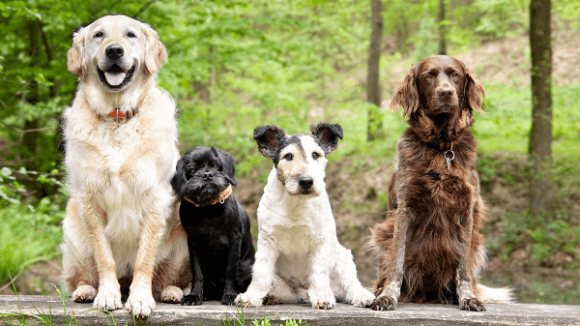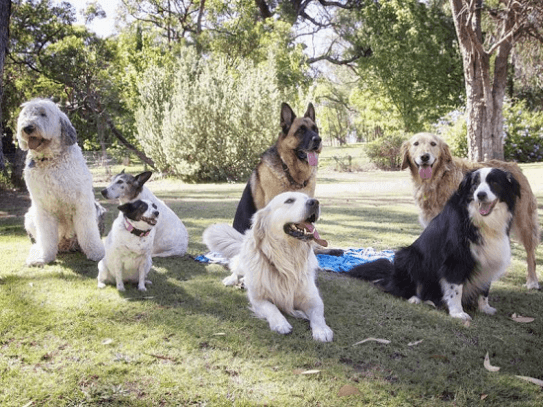Essay on DogDogs are the domesticated descendant of an extinct wolf and the closest relative of the current generation of wolves. The dog was the first mammal tamed by hunter-gatherers some 15,000 years ago, long before the agricultural system was developed. Dogs have spread to or reached many households due to prolonged contact with humans. They have developed the capacity to sustain a starch-rich diet that'd be insufficient for other canids. 
For centuries, dogs have been carefully selected or classified based on their breed for various behaviours, sensory skills, and physical characteristics. Dog breeds differ significantly in shape, size, and colour. They aid people in multiple ways, including hunting, herding, lugging weights, protection, police and military assistance, companionship, therapy, and assisting the crippled. EvolutionThe Cretaceous-Paleogene extinction event happened 65 million years ago, resulting in dinosaur extinction and the rise of the first carnivorans. A carnivoran is an animal that belongs to the order Carnivora. Carnassials are a kind of tooth arrangement found in carnivorans. Over 60 million years, this tooth structure has developed to support meat diets, shattering plants or abolishing the carnassial function, as in seals, sea lions, and walruses. Following the extinction of the dinosaurs, the carnivoran ancestors of the dog-like caniforms and the cat-like feliforms split up. The dog family, Canidae, originated 40 million years ago, with only its subfamily, Caninae, surviving as wolf-like and fox-like canines today. The Canine family first appeared six million years ago, which includes contemporary domestic dogs, wolves, coyotes, and golden jackals. DomesticationThe remains of the first domesticated dog were unearthed in Bonn-Oberkassel, Germany. According to contextual, isotopic, genetic, and morphological data, this dog was not a local wolf. The dog was buried with a man and a woman around 14,223 years ago after being coated with red hematite powder and buried beneath enormous, thick basalt slabs. Canine distemper had killed the dog. Palaeolithic dogs have been described for earlier bones dating back 30,000 years. Nonetheless, their classification as dogs or wolves is debatable because wolves exhibited significant physical variety throughout the Late Pleistocene. DNA sequences demonstrate that all ancient and present dogs originated from an old, extinct wolf population different from the existing wolf lineage. The bones of a Late Pleistocene wolf recovered 14,500 years ago in the Kessleroch cave in Switzerland are linked to most dogs. Both are thought to have shared a common ancestor 32,100 years ago, which suggests that the dog's progenitor was an extinct Late Pleistocene wolf, with the present wolf being the dog's closest surviving relative. For decades, geneticists and archaeologists had struggled to answer the issue of when and where dogs were initially domesticated. According to genetic analyses, domestication began approximately 25,000 years ago in one or more wolf populations in Europe, the high Arctic, or eastern Asia. A research assessment published in 2021 determined that the dog was domesticated in Siberia by ancient North Siberians 23,000 years ago and subsequently migrated eastward into the Americas and westward over Eurasia. BreedsDogs are the most diverse animal on the planet, with over 450 worldwide recognised canine breeds. Directed human selection generated contemporary dog breeds in the Victorian era, resulting in various morphologies. Most species evolved from a limited number of founders over the last 200 years. Because of human-imposed artificial selection, dogs have undergone tremendous phenotypic change and developed into today's modern breeds. The head, body, and limb proportions differ significantly between species, with dogs exhibiting more significant phenotypic variability than the whole order of carnivores. Guarding, herding, hunting, retrieving, and smell detecting are some of their behavioural traits. Their personality qualities include hypersociality, boldness, and hostility, displaying dogs' functional and behavioural variety. As a result, contemporary dogs are the most numerous carnivorous species, and they may be found worldwide. The several current breeds of European descent that emerged during the Victorian era are the most visible evidence of this spread. ReproductionSexual maturity in domestic dogs occurs every six months and/or one year gap for both males and females, but this can be delayed until up to two years for some giant breeds. It is the period when female dogs begin their first oestrous cycle. They will have further oestrous processes semi-annually as the body prepares for pregnancy. Females will become oestrous, or psychologically and physically receptive to copulation, during the apex of the cycle. Fertilisation typically happens two to five days after ovulation; the embryo attaches to the uterus 14-16 days later, and a heartbeat is observable seven to eight days later. Dogs give birth to their litter between 58 and 68 days after conception, with an average of 63 days, while the gestation length varies. A typical female dog consists of six pups. Inbreeding DepressionMating between close relatives is a typical breeding strategy for companion dogs (e.g., half and full siblings). The expression of homozygous harmful recessive variants is primarily responsible for inbreeding depression. Outcrossing between unrelated individuals, such as various breeds of dogs, results in the excellent masking of bad recessive genes in progeny. The various study conducted throughout the decade to study inbreeding indicated that when the inbreeding coefficient grew, litter size reduced, and the percentage of stillborn puppies increased, indicating inbreeding depression. In a Boxer litter study, 22% of puppies perished before reaching the age of seven weeks. Stillbirth was the most common cause of death, followed by infection, and illness mortality climbed considerably as inbreeding grew. BehaviourDog behaviour refers to the domestic dog's (individuals or groups) internally coordinated reactions (actions or inactions) to internal and external stimuli. Dogs' thoughts have unavoidably been changed by millennia of contact with humans as the earliest domesticated species. Due to this physical and social development, dogs have gained the capacity to comprehend and communicate with people more than any other animal. They are highly attuned to human behaviours. According to behavioural experts, domestic dogs have a stunning range of social-cognitive abilities. A 2016 study discovered that just 11 fixed genes differed between wolves and dogs. These gene variants are unlikely to have evolved from normal evolution and suggest that shape and behaviour were selected for during dog domestication. These genes have been linked to the catecholamine production pathway, with the majority influencing the fight-or-flight response and emotional processing. When compared to wolves, dogs display less fear and violence. Some of these genes have been linked to aggressiveness in certain dog breeds, showing their role in early domestication and subsequent breed creation. High sociability and fearlessness in dogs may be caused by genetic changes similar to Williams-Beuren syndrome in humans, which causes extreme friendliness at the price of problem-solving skills. IntelligenceDog intelligence is defined as the dog's capacity to comprehend information and retain it as knowledge for use in problem-solving. According to two dog studies, dogs can learn by inference and have outstanding memory capacities. Rico, a Border Collie, was tested and shown his ability to recognise the labels of over 200 things. It used exclusion learning to learn the names of new things and correctly retrieved those new items instantaneously and four weeks later. Chaser, another Border Collie, was studied for its learning and memory ability. It knew the names and could correlate over 1,000 words with a spoken command. Dogs can recognise and respond to human body language, such as waving and pointing, as well as human verbal orders. Experimental research found that Australian dingos outperform domestic dogs in non-social problem-solving, implying that they may have lost most of their native problem-solving talents when compared to people. Another study found that after being trained to complete a primary manipulation task, dogs experience an unsolvable version of the same difficulty while gazing at humans, whereas socialised wolves do not. CommunicationDog communication refers to how dogs communicate with one another, interpret human signals, and decipher the information that dogs transmit. Eye gazing, facial expression, vocalisation, body posture (including body and limb movements), and gustatory communication are all examples of dog communication behaviours (scents, pheromones, and taste). Humans and dogs communicate through vocalisation, hand gestures, and body position. Lifespan The average lifespan of a dog varies greatly across breeds. Primarily, the median lifecycle spans from 10 to 13 years. When all species are averaged, mixed-breed dogs have a one-year or longer median lifespan than purebred dogs. Higher body weight has been linked to a shorter lifespan in England, and mixed-breed dogs live 1.2 years longer on average than purebred canines. PopulationThe worldwide dog population was predicted to be between 700 million to 987 million in 2013. In industrialised nations, about 20% of dogs are kept as pets. Dogs are typically wild or communally owned in the underdeveloped world, with companion canines being rare. Most of these canines live as scavengers and have never been owned by humans; according to one study, their most common behaviour when approached by strangers is to escape or act violently. Because many current canine cognition surveys have focused on companion dogs living in human homes, little is known about these canines, or the dogs in industrialised nations that are wild, strays, or in shelters. Roles with HumansAs a Pet
Most modern dog owners regard their pets as family members. On the other hand, the popular reimagining of the dog-human family as a pack reflects ambivalence about the link. Some dog trainers, such as those on the TV show Dog Whisperer, have argued for a dominating paradigm of dog-human relationships. However, it has been argued that "attempting to attain status" is not a feature of dog-human interactions. The concept of the "alpha dog" attempting to dominate is based on a debunked assumption about wolf groups. For example, a study of talks in dog-human households discovered that family members utilise the dog as a resource, communicating with it or speaking through it to control their interactions. Many people seek to transform a pet dog into the ultimate companion. Dog groomers, therapists, trainers, carers, dog cafés, spas, parks and beaches, dog motels, airlines, and graves are all available in many cities that show us the importance of dogs in society these days. As the practice of commodifying companion dogs spread, so did the number of dog training books, classes, and television shows. Research comparing people and dogs using magnetic resonance imaging (MRI) found that dogs had the same response to voices and used the same brain areas as humans. This enables dogs to recognise human emotional noises, making them human-friendly social companions. As a Helper
Dogs have coexisted and collaborated with humans in a variety of ways. Historically, they were most useful for hunting, rodent control, and farm herd management. However, they are now required for critical missions such as search and rescue dogs and detection dogs trained to detect illegal narcotics or chemical weapons, guard dogs, dogs that assist fishers with net usage, and dogs that pull freight. Laika, a dog, was the first to be launched into Earth orbit in 1957 on the Soviet Sputnik 2. However, she died during the journey. Individuals with impairments benefit from service dogs and assistance dogs, which include guide dogs, hearing dogs, mobility aid dogs, and mental service dogs. Some dogs owned by people with epilepsy have been seen to warn their guardians when they are going to have a seizure, frequently well in advance, allowing the guardian to seek safety, medicine, or medical care. As a Model/Athlete
People commonly enter with their dogs in breed-conformation shows or sports like racing, sledging, and agility. Individual purebred dogs at conformation exhibits, also known as breed shows, are evaluated by a judge with experience in the specific dog breed for conformity to their defined breed type as described in the breed standard. Because the breed standard primarily addresses externally observable characteristics of the dog (such as look, movement, and temperament), independently assessed traits (such as ability or health) are omitted when grading conformation. Cultural ImportanceDogs represent leadership, protection, loyalty, fidelity, faithfulness, attentiveness, and love. Dogs symbolised Ninisina, the goddess of healing and medicine from the Old Babylonian era through the Neo-Babylonian period. Her devotees regularly presented her with tiny replicas of sitting dogs. Dogs were utilised as magical protection symbols in the Neo-Assyrian and Neo-Babylonian eras. Dogs are regarded as gentle protectors in China, Korea, and Japan. Dogs are frequently used as pets or as watchdogs in mythology. Stories about dogs guarding the underworld entrance appear across Indo-European myths and may have originated in Proto-Indo-European religion. There are many stories or myths concerning dogs. Cerberus is a three-headed, dragon-tailed hound that guards the gates of Hades in Greek mythology. Dogs have also been linked to the Greek goddess Hecate. Garmr, a bloodthirsty four-eyed hound, protects Helheim in Norse mythology. Two four-eyed dogs protect the Chinvat Bridge in Persian folklore. Yama, the Hindu deity of death, possesses two watchdogs with four eyes. They are reported to keep watch over Naraka's gates. A black dog is also regarded as Bhairava's vahana (vehicle) (an incarnation of Shiva). In Christianity, dogs symbolise loyalty, but some schools of thought consider dogs filthy in Islam. However, Khaled Abou El Fadl says this is based on "pre-Islamic Arab tradition" and "a story unjustly imputed to the Prophet". As a result, Sunni Malaki and Hanafi jurists allow the commerce and ownership of dogs as pets. Dogs and other pets are not prohibited under Jewish law, and Jews must feed dogs (and other animals they own) before getting them. ConclusionTo summarise, dogs are excellent swimmers and make fantastic companion animals. They adore their owner and can detect their presence via scent. We must look after them and keep them in good shape. While attitudes toward other animals (particularly cats) have altered drastically over time, the dog has been a consistent companion, buddy, and protector and has been represented in the art and writings of many ancient societies. The historical evidence support that dog is a man's best friend. Nonetheless, no proof is necessary for anyone lucky enough to enjoy the companionship of a lovely dog. There have been many cases over time.
Next TopicSave Environment Essay
|
 For Videos Join Our Youtube Channel: Join Now
For Videos Join Our Youtube Channel: Join Now
Feedback
- Send your Feedback to [email protected]
Help Others, Please Share









